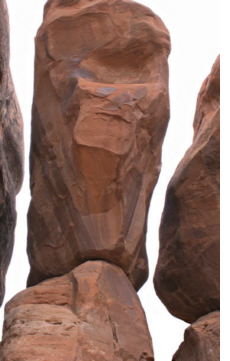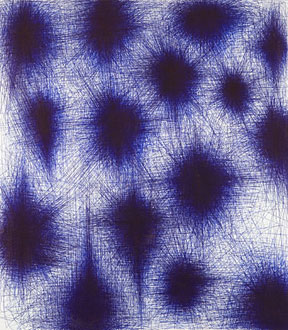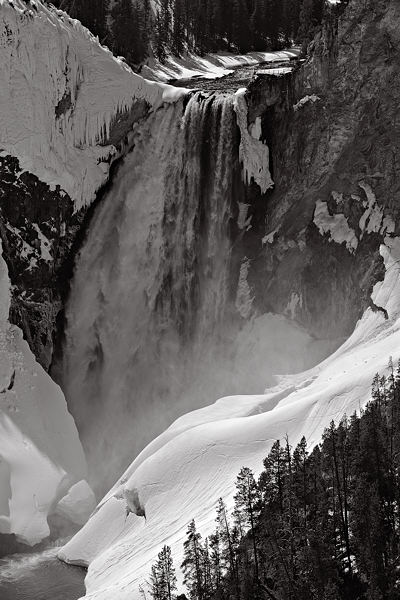As I have indicated here before, I revel in painting faces of our fellow human beings. I am not too sure when it first hit me that painting a face might be a good use of my ‘art’ time, but having hit upon it I find that I am enjoying myself immensely. more… »
Archives for June, 2007
Non-traditional Materials
The “tradition” of using non-traditional materials and found materials in art goes back awhile – from Braques and Picasso’s collages to Duchamp’s urinal. By now we are accustomed to seeing everyday things in the museums or galleries For me, the use of non traditional or found materials has to transform that material so that it becomes something else than the novelty of the material itself. A couple of artists came to mind when thinking about this today. I recently discovered and artist named Il Lee.
BL-069, 2006, Ballpoint pen on canvas, 48 x 42 inches more… »
Rock face
 When I first showed these rock formations I’m calling Bones of the Earth, I was quite unsure what to do with them (I still am…). They seemed to invite a number of treatments. In particular, I found myself wishing I could paint them. Since I’d been admiring Sunil’s paintings of late, I naturally wondered how he might handle them: “Sunil, are you out there? Imagine these rocks as a weathered old face, what would you do with it?” I was not thinking that Sunil would actually see a face in them, but rather that considering the rock surface as skin might suggest coloring and brushwork that would give an interesting treatment. That was before my own musings on the power of face recognition. And if anyone has an over-developed fusiform gyrus in his brain, it’s Sunil (I can barely rotate 90 degrees, he easily does 180). Well, as you can guess, Sunil did see a face there — in fact three — and has recently posted on his blog the painting that resulted. It’s reproduced (with permission) below:
When I first showed these rock formations I’m calling Bones of the Earth, I was quite unsure what to do with them (I still am…). They seemed to invite a number of treatments. In particular, I found myself wishing I could paint them. Since I’d been admiring Sunil’s paintings of late, I naturally wondered how he might handle them: “Sunil, are you out there? Imagine these rocks as a weathered old face, what would you do with it?” I was not thinking that Sunil would actually see a face in them, but rather that considering the rock surface as skin might suggest coloring and brushwork that would give an interesting treatment. That was before my own musings on the power of face recognition. And if anyone has an over-developed fusiform gyrus in his brain, it’s Sunil (I can barely rotate 90 degrees, he easily does 180). Well, as you can guess, Sunil did see a face there — in fact three — and has recently posted on his blog the painting that resulted. It’s reproduced (with permission) below:
Art & Imagination

Painting From Life vs. From Photos
Cennino Cennini devotes his Il Libro dell’ Arte (late 14th c.) to a practical explanation of the materials and techniques of painting. And yet Cennino also writes of painting as an occupation that deserves “to be crowned with poetry”, because the painter has the ability to compose from the imagination, “presenting to plain sight what does not actually exist.”
 It might seem there is a mismatch between focusing on the physical aspects of the work, and at the same time emphasizing the role of imagination in creating art. But this combination of the mundane and the fanciful is appropriate for a simple reason: an artist creating from the world of the mind must nonetheless work in the world of the materials. The physical nature of those materials, and the way the artist uses them, will inevitably influence how the inner world of the mind is discovered and expressed.
It might seem there is a mismatch between focusing on the physical aspects of the work, and at the same time emphasizing the role of imagination in creating art. But this combination of the mundane and the fanciful is appropriate for a simple reason: an artist creating from the world of the mind must nonetheless work in the world of the materials. The physical nature of those materials, and the way the artist uses them, will inevitably influence how the inner world of the mind is discovered and expressed.
Contemporary artist Hanneke van den Bergh recognizes and makes use of this interplay of the imaginary and the physical in her clay sculpture. She explains “I like to make the heads by moving a little lump of clay until I can just see the face. I like this quality of the imaginary form beginning to emerge from the raw material.” Van den Bergh does not attempt to disguise the properties of her materials. In the example shown here, Danae III, she leaves visible the coils with which she constructs the main form. The contrast of the repeating pattern of coils with the rhythm of the body contributes to the expressive effect of the work. “By avoiding too much detail,” she says, “I maintain the contrast between material — the physical — and the imaginary.”
Manhattan Men In Motion

Some weeks ago there was a discussion on this blog about why I don’t photograph people as part of my studies of Manhattan. Since that discussion, I have, of course, become obsessed with photographing people. In case you were looking for an example of how we influence each other on this blog, you now have a very good example.
With all respect for the various and wonderful women of the world, as a man there is an undeniable connection between my brain, my eye and my penis so, not surprisingly as a gay man I have pretty much focused my camera on me…and the streets of Manhattan are chock a block full of beautiful and sexy men. And at the risk of stereotyping and generalizing, as walkers, men and women are very different. Men are going somewhere and they are focused on that–even if it’s nowhere–almost oblivious to there surroundings. Women are observers. They’re moving more slowly and looking at store windows, how other women are dressed, what possible threats there may be to their safety–and if they’re being led by a man, they are never looking forward. It’s actually pretty funny to observe.

I’ve also learned that male Manhattanites are so focused on their “missions” that you can stick a camera up a man’s ass and he’s likely not to notice unless it has a vibration mode–and even then he might mistake it for a passing subway train. As a result I’m loving the ability to capture unposed body language and, more specifically, Manhattan male motion.

How to find a style? –Cennino’s take
Sometime in the 14th century, Cennino Cennini wrote Il Libro dell’Arte as advice for how to be an artist. One of the most interesting passages, I think, is how an artist should go about developing a personal style. Cennini begins:
take pains and pleasure in constantly copying the best things which you can find done by the hand of great masters. And if you are in a place where many good masters have been, so much the better for you.
The point of the exercise is to learn from the source. This means that the choice of master to copy is important. Cennini continues:
But I give you this advice: take care to select the best one every time, and the one who has the greatest reputation. And, as you go on from day to day, it will be against nature if you do not get some grasp of his style and of his spirit.
Selecting the right masters to copy is still not enough. Cennini recognized that the particular interpretations of one artist needed to be studied consistently:
For if you undertake to copy after one master today and after another one tomorrow, you will not acquire the style of one or the other, and you will inevitably, through enthusiasm, become capricious, because each style will be distracting your mind. You will try to work in this man’s way today, and in the other’s tomorrow, and so you will not get either of them right.
By choosing the right artist to study, and by studying his work consistently before studying that of another artist, one will achieve the preconditions for finding a personal style:
If you follow the course of one man through constant practice, your intelligence would have to be crude indeed for you not to get some nourishment from it. Then you will find, if nature has granted your any imagination at all, that you will eventually acquire a style individual to yourself, and it cannot help being good; because your hand and your mind, being always accustomed to gather flowers, would ill know how to pluck thorns.

